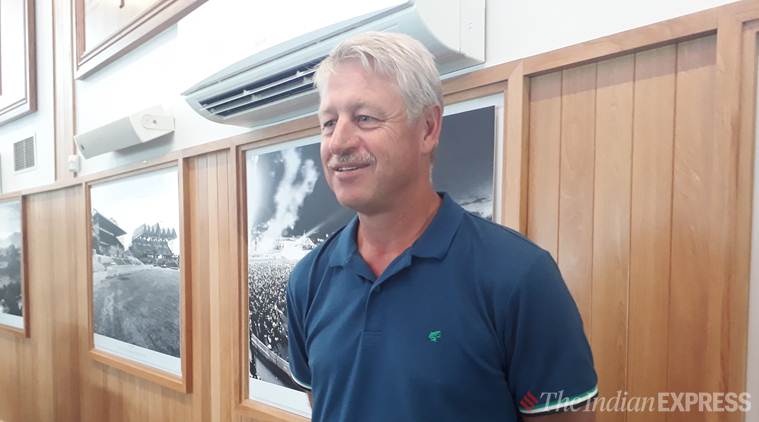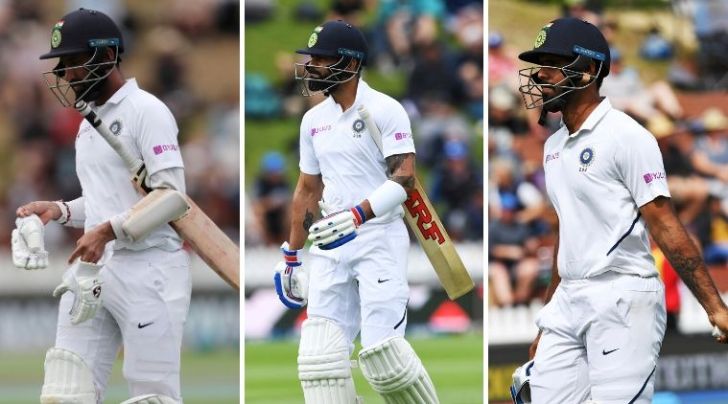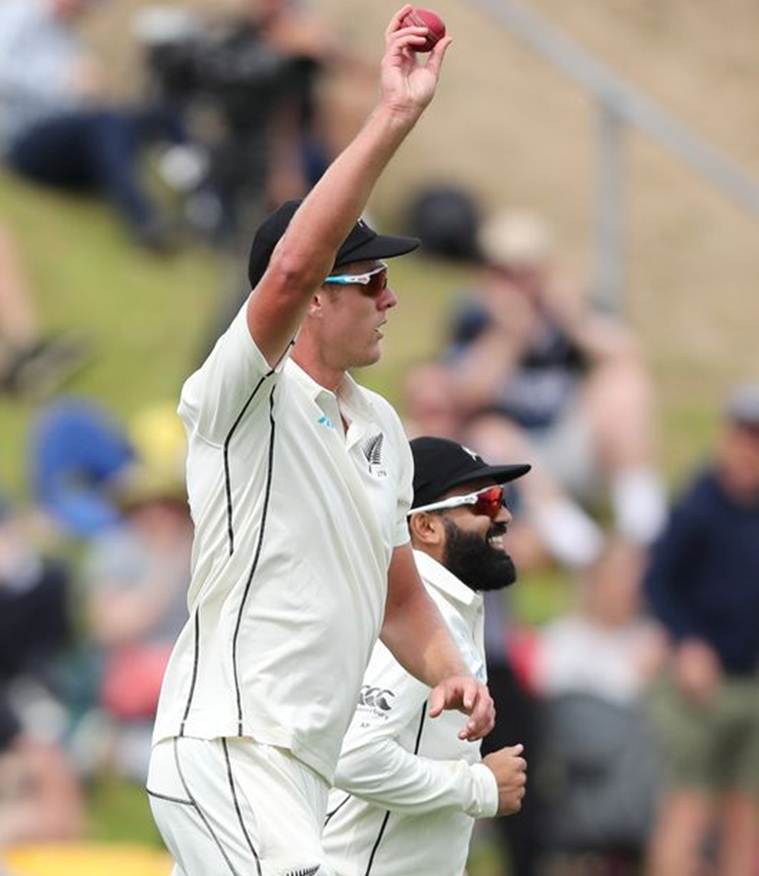Shared News| February 22, 2020 7:59:16 am
Virat Kohli and Kyle Jamieson on Day 1 of the first Test between India and New Zealand. (REUTERS)
Basketball or cricket? It was the 6 feet and 8 inches tall Kyle Jamieson’s first dilemma. Lanky, athletic, and an NBA tragic, it’s barely surprising that he plied basketball well into his teens. A point-guard with a penchant for three-pointers, he was on a representative squad and did some academy work with the New Zealand Breakers for a year. At the same time, he was making rampant strides in cricket, as an all-rounder who opened the batting and took the new ball. But when he was around 11 arrived the moment to pick between the two sports.
His father, Michael, who still opens the batting for Papatoetoe’s 2B side, knew he would pick cricket. Not because he wanted him to be one, or ever forced him to be one, but he had realised the fire in his son when he was barely eight. “He might have been eight and we were watching a New Zealand game on the television. I think it was happening at the Basin Reserve only, when he came and told me, ‘dad, I want to be a Black Cap.” An eight-year-old’s muttering, he thought.
Not a pushy father, he had just one advice to his son. “So I told him one day, I’m happy to help you. I’m happy to come and throw balls in the nets. If you never made the Black Caps, it wasn’t going to be due to lack of trying. If you weren’t good enough that’s fine but wasn’t going to be because you hadn’t done the hard work,” recollects Michael, who had to scramble for a flight ticket from Auckland to Wellington after Jamieson was informed of his Test debut on Thursday.

Kyle Jamieson’s father Michael. (Express Photo by Sandip G)
Jamieson, though, admits he was frankly not good at basketball. “I don’t know how far I actually would have gone. My jump height is not the greatest, so look, I certainly enjoyed playing both sports growing up, and it probably hit around year 11, where it just became quite full-on, to balance between the two. So yeah, just stuck with cricket, and I think it seems to be paying off a little bit now,” he said after his dream Test debut, wherein he nailed the two pillars of Indian batting, Virat Kohli and Cheteshwar Pujara, besides the in-form Hanuma Vihari.
Low jump height
His jump height is not great when he’s bowling either. He decelerates as he approaches the crease, nearly stops in his run-up before he releases the delivery. It’s innocuous but not unorthodox action. He could send down innocuous deliveries too. Like those he employed to dismiss Pujara and Vihari, full deliveries that held the line or moved away fractionally. Not the usual dismissal modes you’d expect from a gangly bowler. Normally, tall men as him, trade their wickets with back-of-length or short-pitch stuff at top pace. Think of Morne Morkel or Curtly Ambrose. Even Joel Garner bowled full only when he tried yorkers.

Jamieson grabs Pujara, Kohli and Vihari’s wicket.
Jamieson is neither a back-of-length peddler nor a pace machine. His maximum speed was 132 kmph and mostly dwelled on good or full length, though he did illustrate his mastery of different lengths.
So the fuller length, which he intersperses with back-of-length deliveries, surprises batsmen. Explains Jamieson: “I think as a tall guy, naturally your length is further back, but over time you get used to trying to bring it a little bit fuller. With my height, I can afford to go a fraction fuller, especially out here, with the extra bounce,” he says. The deceptive blend of height, bounce and movement was incomprehensible to the Indian batsmen, the best of them.
Thus, Jamieson has achieved enough in the last month—his dream debut and ODI heroics—to be never afflicted with the road not taken regret.
Bat or ball?

Kyle Jamieson celebrates with teammates after taking a catch to dismiss Mayank Agarwal. (REUTERS)
Not long ago, his idea of a dream debut was reaching a hundred. For he began as a middle batsman for Auckland Grammar School, an aggressive batsman like his father. For three successive years, he topped the run charts in school cricket and got picked primarily as a batsman in the U-19 World Cup in 2014, but impressed as a bowler (7 wickets) more than a batsman (29 runs).
“He was sort of 60-40, batting over bowling. Always a genuine all-rounder. Normally batted in the top 4 or 5 in the early stuff and bowled sort of first-change, second-change. Going through high-school in first XI cricket, under-14 under-15 and under-16, he would open the batting and the bowling. Or bat No.3 and bowl first-change,” says Michael.
But gradually, as he got beefier and broader, coaches and captains began to harness his bowling. “He still bats well, but there came a time when he subconsciously started to focus more on his bowling. He’s really started to get a bit stronger in the last couple of years, and that’s really helped with (avoiding) injuries. Before he was a tall lanky lad with not a huge amount of muscle, and he’s worked hard on that in the gym which has helped to support his frame. Maybe, it has helped him to be a better bowler,” says Michael.
Focus on fitness
It took an injury for him to start focussing on fitness. He broke a bone down the side of his foot and the doctors put a screw in. Then the screw broke again. Thus, he realised he needs to be fitter. Those were the darkest days of his career. “You could see it really affected him because it was a case of ‘hey I am not going to get to play the sport I love for a little while’ and stuff like that,” Michael remembers.
As he leaped over higher levels, his batting became inadequate. “He did struggle to take the step up with the bat whereas he managed to step up with the ball. Then in the last couple of years, he’s done a lot of work with his batting and was getting used to the change of roles,” he says. But in the backyard, his father struggles to snatch the bat from him. And India would vouch for his batting skills, the influential role he played.
In an ideal world, Michael wants to see him excel in both batting and bowling. “He’s done a lot of work with his batting and was getting used to the change of roles. It’s a different role from batting at the top of the order to batting down where you’re batting at the end of the innings and you’re now starting to look at run-rates and who’s at the other end. He now understands his role. And hopefully, you can see more of his batting,” he avers.
Another dilemma
Auckland or Canterbury? It was his latest dilemma. Jamieson moved to Canterbury on a sports scholarship with the Lincoln University when he was 18. There he met the now New Zealand coach Gary Stead, who mentored him, and played five years for them. But then came a time when he was split between staying there or moving back. After much deliberation, he decided to return home.
“I wasn’t enjoying it and wasn’t really liking the person I was in the field sometimes as well. It was just a shift that I needed to make – I thought that, most importantly, I needed to be happy and I needed to enjoy my cricket and then wherever that might take me, it would,” he recently said in a press conference upon joining Auckland.
The fruits of his labour remaining unrequited, he was in a negative state of mind so much that he consulted New Zealand Cricket’s mental skills coach, Pete Sanford to better understand himself. “That mental space is such an important part of life, not just as a cricketer, and that’s something I always keep tapping into, to keep things in check,” he said.
The decision became easier to make after Henrich Malan, who was the NZ A coach, took over the reins of Auckland. “Kyle just felt Henrich had something to offer him and just a different voice. I think it was just a timing thing. And it’s working well,” he says.
Back in Auckland, the negativity dissipated, he began to enjoy his cricket again and regained his drive. “He’s a different person now. Very, very competitive and happy,” says Michael. Both happiness and competitiveness have flown into his cricket too. He’s in that state of mind where he has no dilemmas.




